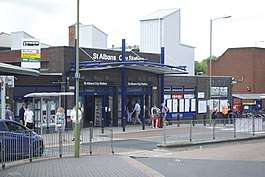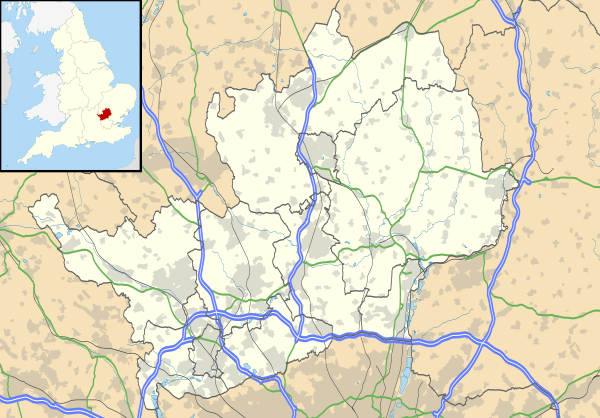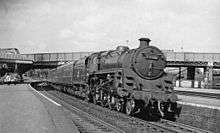St Albans City railway station
St Albans City railway station, also known simply as St Albans, is one of two railway stations serving the city of St Albans in Hertfordshire, England (the other being St Albans Abbey). The 'City' station is the larger of the two, as it is on the better-connected Midland Main Line 19 miles 71 chains (32.0 km) from London St Pancras, being served by Govia Thameslink trains on the Thameslink route.
| St Albans City | |
|---|---|
 Exterior of the main building on Station Way | |
 St Albans City Location of St Albans City in Hertfordshire | |
| Location | St Albans |
| Local authority | City of St Albans |
| Grid reference | TL155070 |
| Managed by | Thameslink |
| Station code | SAC |
| DfT category | D |
| Number of platforms | 4 |
| Accessible | Yes |
| National Rail annual entry and exit | |
| 2014–15 | |
| 2015–16 | |
| 2016–17 | |
| 2017–18 | |
| – interchange | 0.110 million[1] |
| 2018–19 | |
| – interchange | |
| Key dates | |
| 1 October 1868 | Opened |
| Other information | |
| External links | |
| WGS84 | 51.7504°N 0.3274°W |

Railway stations in St Albans | |||||||||||||||||||||||||||||||||||||||||||||||||||||||||||||||||||||||||||||||||||||||||||
|---|---|---|---|---|---|---|---|---|---|---|---|---|---|---|---|---|---|---|---|---|---|---|---|---|---|---|---|---|---|---|---|---|---|---|---|---|---|---|---|---|---|---|---|---|---|---|---|---|---|---|---|---|---|---|---|---|---|---|---|---|---|---|---|---|---|---|---|---|---|---|---|---|---|---|---|---|---|---|---|---|---|---|---|---|---|---|---|---|---|---|---|
| |||||||||||||||||||||||||||||||||||||||||||||||||||||||||||||||||||||||||||||||||||||||||||
History
The station was built by the Midland Railway in 1868, on its extension to St Pancras. St Albans was famous for producing watercress, which was sent in 56-pound (25 kg) lots to London and Manchester.
The other station, St Albans Abbey, was built by the London and North Western Railway in 1858. There was originally a further station called London Road, built by the Hatfield and St Albans Railway in 1863 to connect with the Great Northern Railway.[2]
Station masters
- Joseph William Eden 1868 - 1877
- T.B. Nichols 1877 - 1883[3] (formerly station master at Rugby, afterwards station master at Bedford)
- George Alfred Wright 1884[4] - 1905[5] (formerly station master at Bingley)
- Thomas Pitt 1905 - 1916[6] (afterwards station master at Burton on Trent)
- G.A. Yates 1916[7] - ???? (formerly station master at Dronfield and Unstone)
- E. Jones 1920[8] - ???? (formerly station master at Higham Ferrers and Harpenden)
- George E. Howlett 1930[9] - 1941 (formerly station master at Sutton Coldfield)
Description
The station has four platforms, two for each direction: one "fast" and one "slow". The main entrance, ticket office, multi-storey car park, taxi rank and bus connections are on Station Way, east of the station. There is a second exit to the west, to a small surface car park off Ridgmont Road and Victoria Street, located at the original entrance to the station. A larger surface car park to the east of the railway lines gained planning permission in 2003, in connection with a large residential development.[10]
There are ticket barriers at both entrances.
The station participates in the Plusbus scheme where combined train and bus tickets can be bought at a reduced price.
There is also a newsagent and refreshment shops. Just outside the station there is a flower stall.
St Albans South signal box has been restored at the station and has been opened as a visitor attraction by the St Albans Signal Box Preservation Trust.[11]
Services
As of May 2018 the typical off-peak service in trains per hour (tph) is:
- 4tph to Bedford
- 2tph to Luton
- 2tph to Brighton via Gatwick Airport
- 2tph to Gatwick Airport via Redhill
- 2tph to Rainham via Greenwich & Dartford
- 2tph to Sutton via Wimbledon
- 2tph to Sutton via Mitcham Junction
The service in the late nights is a Thameslink service from Bedford to Three Bridges stopping at all stations to London St Pancras International
| Preceding station | Following station | |||
|---|---|---|---|---|
| Thameslink | St Pancras International |
|||
| Thameslink Thameslink | ||||
| Terminus |
Gallery
- St Albans City rail station (view from platform 1)
 Northward view from the island platforms (Platforms 2 and 3). The points at the right are used by northbound terminating trains to access the southbound Platform 1 for the return trip.
Northward view from the island platforms (Platforms 2 and 3). The points at the right are used by northbound terminating trains to access the southbound Platform 1 for the return trip..jpg) Northbound Midland Mainline train, formed of Class 222 Meridian units, passing through Platform 4. East Midlands Trains services regularly pass through the station but do not stop.
Northbound Midland Mainline train, formed of Class 222 Meridian units, passing through Platform 4. East Midlands Trains services regularly pass through the station but do not stop. General view across the station, from the Victoria Street bridge
General view across the station, from the Victoria Street bridge Buildings on the island platform
Buildings on the island platform
References
- "Station usage estimates". Rail statistics. Office of Rail Regulation. Please note: Some methodology may vary year on year.
- Radford, B., (1983) Midland Line Memories: a Pictorial History of the Midland Railway Main Line Between London (St Pancras) & Derby London: Bloomsbury Books
- "Bedford". Northampton Mercury. England. 1 March 1907. Retrieved 4 March 2020 – via British Newspaper Archive.
- "Presentation to the Bingley Station Master". Shipley Times and Express. England. 12 January 1884. Retrieved 4 March 2020 – via British Newspaper Archive.
- "Midland Stationmaster. Farewell to Mr. G.A. Wright". Herts Advertiser. England. 9 December 1905. Retrieved 4 March 2020 – via British Newspaper Archive.
- "M.R. new staff appointments". Derby Daily Telegraph. England. 21 October 1916. Retrieved 16 September 2017 – via British Newspaper Archive.
- "The new M.R. stationmaster at Burton". Derby Daily Telegraph. England. 21 May 1920. Retrieved 16 September 2017 – via British Newspaper Archive.
- "M.R. Station Staff Changes". Derby Daily Telegraph. England. 20 December 1916. Retrieved 16 September 2017 – via British Newspaper Archive.
- "Railway Promotion". Birmingham Daily Gazette. England. 8 December 1930. Retrieved 16 September 2017 – via British Newspaper Archive.
- "Network Rail Proposed Land Disposal: St Albans, Hertfordshire" (PDF). Web.archive.org. Retrieved 16 December 2018.
- "SigBox Website". Sigbox.co.uk. Retrieved 16 December 2018.
Sources
- Butt, R. V. J. (1995). The Directory of Railway Stations: details every public and private passenger station, halt, platform and stopping place, past and present (1st ed.). Sparkford: Patrick Stephens Ltd. ISBN 978-1-85260-508-7. OCLC 60251199.
External links
| Wikimedia Commons has media related to St Albans City railway station. |
- Train times and station information for St Albans City railway station from National Rail